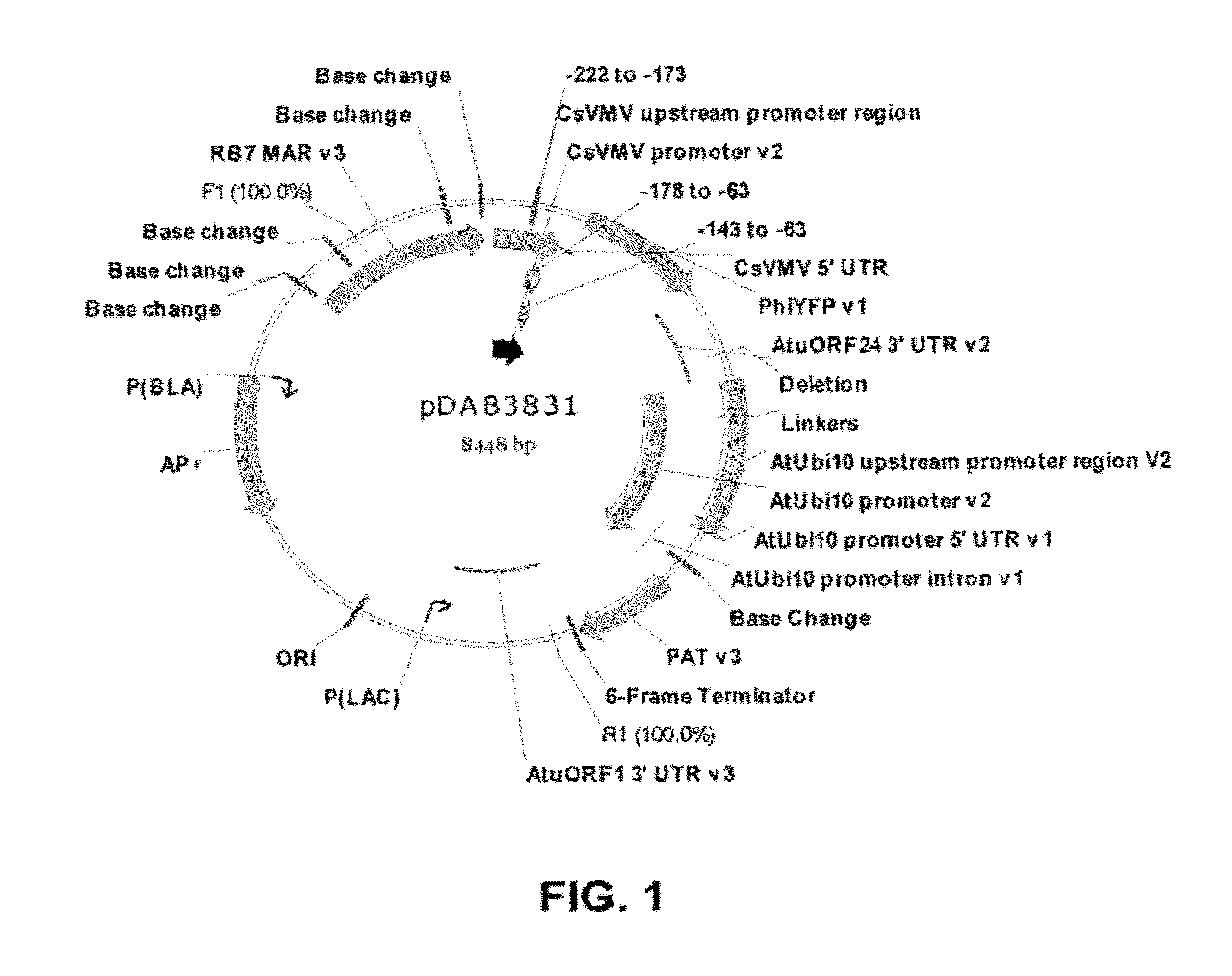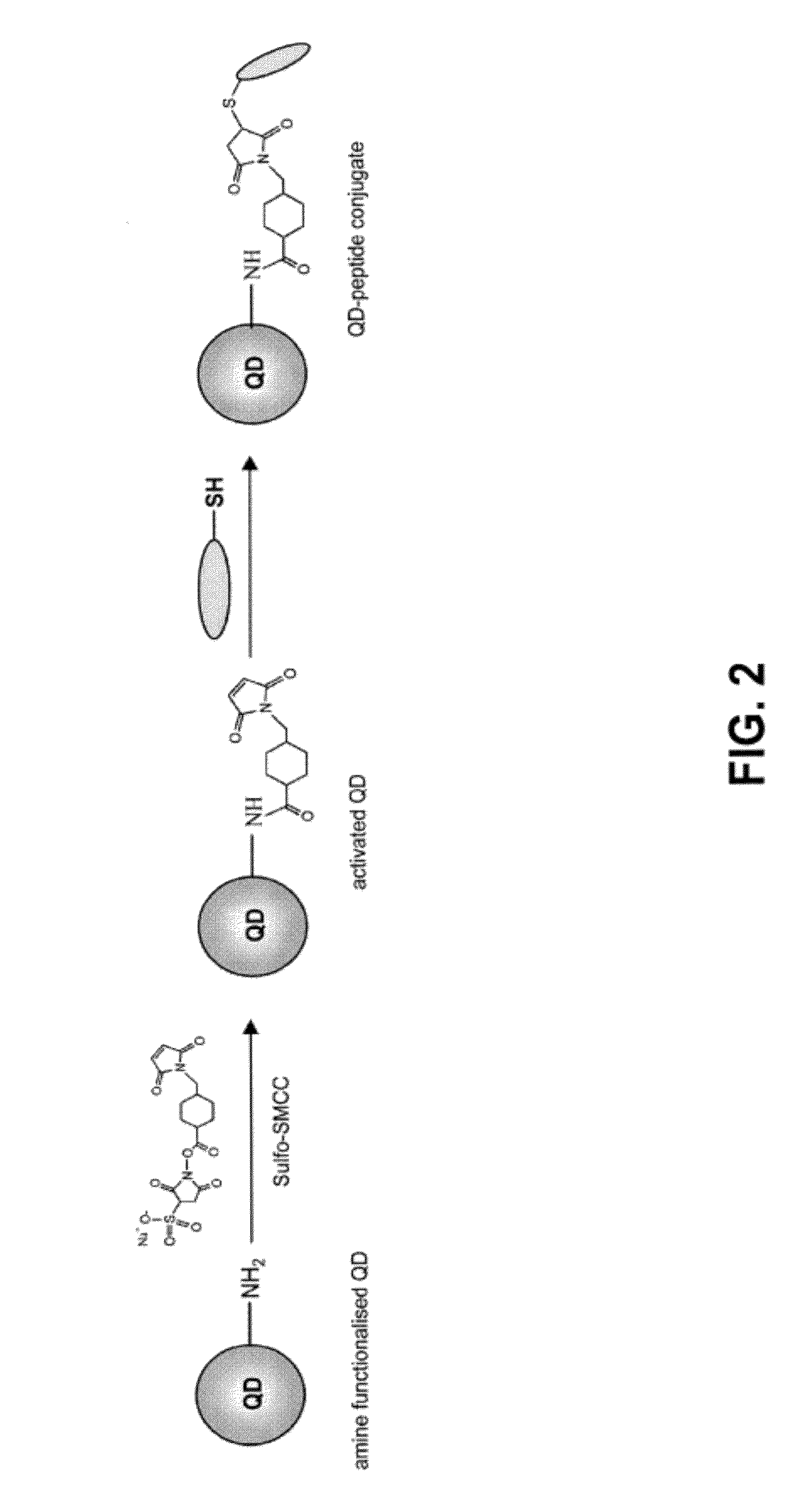Quantum dot carrier peptide conjugates suitable for imaging and delivery applications in plants
- Summary
- Abstract
- Description
- Claims
- Application Information
AI Technical Summary
Benefits of technology
Problems solved by technology
Method used
Image
Examples
example 1
Synthesis of Peptides
[0087]The following Cell Penetrating Peptide (CPP) sequences; R9 (Futaki et al., 2001, Suzuki, et al., 2002), MPG (Morris, 1997 and Morris, 1999), and γ-ZEIN (Kogan et al., 2001 and 2002) are listed in Table 1. These peptides were synthesized by the American Peptide Company (Sunnyvale, Calif.) as C-terminal amides. The integrity of the samples was tested using Mass Spectrophotometer using art recognized protocols.
TABLE 1 Amino Acid Sequences and Molecular Massesof the Synthesized PeptidesMolecularSEQ ID NO:Peptide SequenceWt(gm / mole)1SEQ ID NO: 1R9RRRRRRRRR14.232SEQ ID NO: 2MPGGALFLGFLGAAGSTMGAWSQPKKKRKV28.073SEQ ID NO: 3γ-ZEIN(VRLPPP)319.98
Preparation of Quantum Dot—Peptide Conjugates
[0088]Quantum dot (QD) and CPP conjugates were produced. Amine-functionalized quantum dots, purchased from EvidentTech (Troy, N.Y.), were activated by adding approximately 1 mg of sulfo-SMCC to 200 μl of amine quantum dots (QD514; n=2.3 nmol) in 200 μl of 50 mM sodium phosphate pH ...
example 2
Live Imaging in Planta Via Quantum Dot Cell Penetrating Peptide Conjugates
Live Imaging via DHLA-Capped QD and QD-CPP Conjugate
[0101]Fusion proteins consisting of Cell Penetrating Peptides (CPP) and Yellow Fluorescent Protein (YFP) were produced and isolated as previously described in U.S. Provisional Patent No. 61 / 319,764 and Chen et al., 2007. The various cell penetrating peptides were sub-cloned up-stream of the YFP coding sequence at unique NcoI-SpeI restriction sites within a pET280 bacterial expression vector. Expression of the proteins was induced, and they were isolated and purified as described in U.S. Provisional Patent No. 61 / 319,764 and Chen et al., 2007. The sequences of the CPP-YFP fusions are listed in Table 3.
TABLE 3 Nucleotide Sequences of Cell Penetrating Peptide and Yellow Fluorescent Protein FusionsNameSEQ ID NO:SequenceTAT-YFPSEQ ID NO: 8atgtatggccgcaaaaaacgccgccagcgccgccgccatcatcatcatcatcatggatccagcggcgccctgctgttccacggcaagatcccctacgtggtggagatggagggcaatgtggatggcc...
example 3
Live Imaging in Planta Via Polystyrene Cell Penetrating Peptide Conjugates
[0111]The delivery and cellular localization of polystyrene nanoparticles fused with CPPs was completed. The complexed polystyrene / CPP nanoparticles were translocated into live plant cells and targeted to specific cell compartments.
[0112]Internalization of polystyrene nanoparticles was labeled with the Cell Penetrating Peptide, TAT, in JTNT1 tobacco single cells.
Conjugation of Tat Peptide to Carboxylated FluoSpheres
[0113]Evaluation of the uptake of FluoSphere fluorescent polystyrene nanoparticles (20 nm diameter) into walled JTNT1 tobacco single cells was tested with and without a partial TAT cell penetrating peptide.
[0114]FluoSpheres (Invitrogen, Carlsbad, Calif.) were obtained from 4° C. storage and prepared by adding 1-Ethyl-3[3-dimethylaminopropyl]carbodiimide hydrochloride (EDCL) and N-hydroxysuccinimide (NHS). The resulting cocktail was incubated for 1 hour to allow the EDCL to react with the FluoSpheres...
PUM
 Login to View More
Login to View More Abstract
Description
Claims
Application Information
 Login to View More
Login to View More - R&D
- Intellectual Property
- Life Sciences
- Materials
- Tech Scout
- Unparalleled Data Quality
- Higher Quality Content
- 60% Fewer Hallucinations
Browse by: Latest US Patents, China's latest patents, Technical Efficacy Thesaurus, Application Domain, Technology Topic, Popular Technical Reports.
© 2025 PatSnap. All rights reserved.Legal|Privacy policy|Modern Slavery Act Transparency Statement|Sitemap|About US| Contact US: help@patsnap.com


